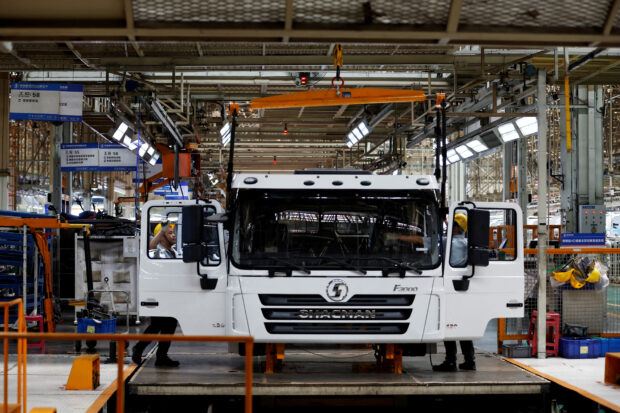Asia’s factory output slumps as weak China demand weighs

Employees work on the trucks production line during an organised media tour to the Shaanxi Automobile Group factory in Xian, Shaanxi province, China May 17, 2023. REUTERS/Florence Lo/File photo
TOKYO – Asia’s factory activity slumped in June, business surveys showed on Monday, as sluggish demand in China and advanced nations clouded the outlook for the region’s exporters.
While manufacturing activity expanded marginally in China, it contracted in powerhouses Japan and South Korea as Asia’s fragile economic recovery struggled to maintain momentum.
The surveys underscore the toll China’s weaker-than-expected rebound from COVID lockdowns is inflicting on Asia, where manufacturers are also bracing for the fallout from aggressive U.S. and European interest rate hikes.
READ: China’s April data show economic recovery losing steam
“The worst may have passed for Asian factories but activity lacks momentum because of diminishing prospects for a strong recovery in China’s economy,” said Toru Nishihama, chief emerging market economist at Dai-ichi Life Research Institute.
READ: Asia’s factories struggle for momentum amid patchy recovery
“China is dragging its feet in delivering stimulus. The U.S. economy will likely feel the pain from big rate hikes. These factors all make Asian manufacturers gloomy about the outlook.”
China’s Caixin/S&P Global manufacturing purchasing managers’ index (PMI) eased to 50.5 in June from 50.9 in May, the private survey showed on Monday, staying above the 50-point index mark that separates growth from contraction.
The figure, combined with Friday’s official survey that showed factory activity extending declines, adds to evidence the world’s No. 2 economy lost steam in the second quarter.
The impact is being felt in Japan where the final au Jibun Bank PMI fell to 49.8 in June, returning to a contraction after expanding in May for the first time in seven months.
New orders from overseas customers decreased in June at the fastest rate in four months reflecting feeble demand from China, the Japan PMI survey showed.
South Korea’s PMI fell to 47.8 in June, from 48.4 in May, extending its downturn to a record 12th consecutive month on weak demand in Asia and Europe.
READ: South Korea factory activity suffers longest downturn in at least 19 years
Factory activity also contracted in Taiwan, Vietnam and Malaysia, the PMI surveys showed.
Asia’s economy is heavily reliant on the strength of China’s economy, which saw growth rebound in the first quarter but subsequently fell short of expectations.
The fate of Asia’s economy, including China’s, will have a huge impact on the global economy with aggressive monetary tightening to curb inflation likely to weigh on U.S. and European growth.
In forecasts released in May, the International Monetary Fund said it expects Asia’s economy to expand 4.6 percent this year after a 3.8 percent gain in 2022, contributing around 70 percent of global growth.
But it cut next year’s Asian growth forecast to 4.4 percent and warned of risks to the outlook such as stickier-than-expected inflation and slowing global demand.
Read Next
Subscribe to INQUIRER PLUS to get access to The Philippine Daily Inquirer & other 70+ titles, share up to 5 gadgets, listen to the news, download as early as 4am & share articles on social media. Call 896 6000.
For feedback, complaints, or inquiries, contact us.
For all the latest Business News Click Here
For the latest news and updates, follow us on Google News.



